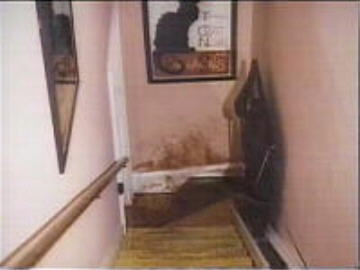|
"Michael is explaining to us that this weird thing happened -- she had fallen down the steps."
-- Elizabeth Ratliff's neighbor, Cheryl Appel-Schumacher
"We knew it would come back at some point. We knew it wasn't finished."
-- Ratliff's friend, Amybeth Berner
"1810 Cedar Street. Please! My wife had an accident. She's still breathing! She fell down the stairs. She's still breathing! Please come!"
-- Michael Peterson
"I assumed he was talking about the spiral staircase."
-- Candace Zamperini
Michael Peterson's 14-room mansion was featured in a 1998 Herald-Sun News item about Durham's annual "Old Durham Home Tour." In the article, Jane Goodridge, of the Historic Preservation Society describes Peterson's elegant house which was originally designed by John Buchanan and architect George Watts Carr in 1940.
The April 19, 1998 article reads:
When Jane Goodridge, tour chairman, speaks of the John Buchanan House, her thoughts immediately turn to the staircase.
"It's probably one of the most beautiful I've ever seen," Goodridge said. "It's just an outstanding architectural feature."
Appearing in the paper's Home & Garden section, the piece wasn't intended to relay information about a crime, yet it holds clues to the central item in Michael Peterson story: the staircase. Repeatedly, the article points out the dramatic circular staircase in the mansion's front room.
"I thought it was a spectacular home," Kathleen Peterson said from the bottom of the curved staircase that leads into the foyer, "just the grandeur."
Three years after the Herald-Sun piece was published, Kathleen Peterson would be found at the bottom of a staircase -- not the one mentioned in the article -- but the rather typical staircase at the back of the house.
When word first spread of Kathleen Peterson's fatal fall down the stairs, many of the family's acquaintances thought she had died falling down the mansion's grand, circular stairs. It's easy to imagine someone could be seriously injured or even die after an accidental plummet down such a stair unit.
The back steps are another story.
After Kathleen Peterson's death, Michael and his defenders constantly emphasized in the press how "narrow, darkly lit and dangerous" the back steps were. They often noted the metal chair-lift going up the side wall. Sonya Pfeiffer, from Durham's local ABC News reported the following on February 7, 2002:
In the cast of the seemingly Hollywood-chosen characters, the staircase is possibly the most enigmatic. It is described as narrow, steep, dangerous, and given life by Hollywood when it was used in the filming of "A Handmaid's Tale."
Attorney, David Rudolf repeated the "narrow, steep" refrain, alleging Mrs. Peterson unsuccessfully "tried to walk up a narrow, poorly lit stairway in flip-flops."
At 42-inches wide, the back steps with the old chair-lift contraption may well have been narrow, but Kathleen Peterson had lived in the house for over a decade. Her daughter Caitlin Atwater commented, "I've walked up that staircase thousands of times. So has Michael. No one else has fallen down it."
Elizabeth Ratliff's daughter, Margaret saw things differently. "When I first heard how my second mom died -- Kathleen died -- it came in my mind almost instantly: Wow, they both fell down the stairs, which was very odd. But at the same time, total coincidence really. It's just terrible. Also... old homes, steep staircases."
Despite all the talk about how unusually dangerous the steps were, by the time the case went to trial, Michael's defense team agreed with State prosecutors that the evidence proved Kathleen Peterson wasn't in the dark, steep stairwell. David Rudolf told jurors Mrs. Peterson may have been attempting to walk up the stairs but that she never made it past the first few steps.
How Many Stares?
When not being used as the set for a Hollywood movie, the Cedar Street mansion's rather unremarkable back steps had only one truly striking feature: the Black Cat at the bottom.

Visitors to the Peterson's Forest Hills home were treated to a dazzling assortment of unique art and artifacts. But hanging inside the stairwell of the side hall, Michael's copy of T. A. Steinlen's "Chat Noir" had barely been noticed. The Black Cat hid there for years and gazed knowingly at everyone who happened to reach the bottom of those dark, dangerous stairs.
When the painting appeared in crime scene photos surrounded by swipes and spatters of blood, it became the most prominent work of art in Michael's mansion. Many who knew of Peterson's past were stunned by the fact that the Black Cat was also sitting at the bottom of Elizabeth Ratliff's staircase in her house in Germany.
Barbara Malagnino, Elizabeth Ratliff's nanny, told jurors she remembered first seeing the Chat Noir in 1983: "This cat picture was hanging in my room when I was living in Graefenhausen."
Elizabeth Ratliff's sister, Margaret Blair testified that several items she'd seen in Michael's mansion originally belonged to Elizabeth. Among other pieces of art, Blair specified the Steinlen print, saying, "The cat, at the foot of the stairs -- was recognized as my sister's -- the place where Kathleen died."
Margaret Blair had no doubt. The same Chat Noir hung on the wall in 1985 and gazed knowingly at Elizabeth Ratliff's murder from the bottom of the stairs. When Liz Ratliff was found dead in her hallway, the Chat Noir was surrounded by surreal amounts of blood.
"The blood went all the way up the staircase."
-- Cheryl Appel-Schumacher
"There was a lot of blood. There was blood up the staircase wall. There appeared to be a lot of blood spattered in different places around the foyer area."
-- Tom Appel-Schumacher
Peterson's team dismissed the Black Cat, the blood, and the staircases as spooky coincidences, and directly challenged the charge that Peterson had stolen property. Similar to Michael's multiplying blowpokes, his lawyers elicited subsequent testimony suggesting there were two Black Cats. David Rudolf indicated Peterson had purchased his own Chat Noir in 1997.
Coincidentally, 1997 was the year Michael married Kathleen.
Portraying
Kathleen Peterson
|
 |

